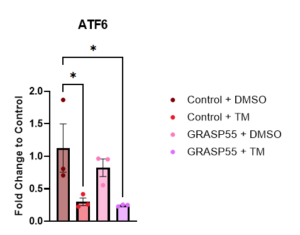Week 8 – Plot Twist!
Anita M -
Hello everybody,
This week we ran our qPCR to measure gene expression. After analyzing our data we noticed something off…
Just as a quick reminder, previous literature has proved that ATF6 is activated in response to ER Stress. Tunicamycin (TM) causes ER Stress in Cells. Therefore, cells treated with TM should have increased expression of ATF6.
However, when we look our data, we noticed that in both the GRASP55 and control groups, the TM treated cells had significantly lower gene expression than the control group. Here is a picture for reference:

Just to help make some things clear:
— DMSO is a control treatment, TM is an experimental treatment
— DMSO is a control treatment, TM is an experimental treatment
— The absolute control of this experiment is the first bar. It has no GRASP55 overexpression and no TM treatment. Therefore, every other bar is compared to the first bar
— the * symbol indicates a significant difference between groups
— The two short bars you see are the TM treated ones
Now, here’s the graph of the second gene, GRP78, expression

Notice a pattern?
The TM treated cells are significantly lower in both cases.
Now what can we conclude from this?
Well, I want to remind you of the relation between ER stress and ATF6. ER stress (aka a TM treatment) should increase ATF6 gene expression. We know that certainly. Look at the red bar in the first image and compare it to the brown bar. It is significantly lower. This means we can’t really conclude much from our cells that had the TM treatment AND overexpression of GRASP55 (purple bar) because our control TM treatment (red bar) did not act the way we expected it too. This means we cannot reliably compare our data and draw a certain conclusion.
However, we can hypothesize what went wrong. We suspect the TM dose was too high and/or left on for too long. To mitigate this in the future, we would run a dose curve to determine what the ideal concentration of TM is. Unfortunately, that would take another two weeks and re-running the experiment afterwards would exceed the timeframe of the senior projects. I do look forward to potentially continuing this research after the conclusion of these 10 weeks, but for now we are still left in a bit of suspense.

Comments:
All viewpoints are welcome but profane, threatening, disrespectful, or harassing comments will not be tolerated and are subject to moderation up to, and including, full deletion.